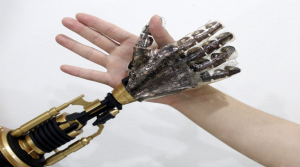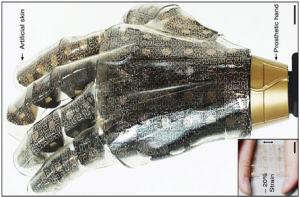It is easy to take something for granted when that something is attached to your body. If you were out in the snow one day and grabbed some snow with your gloves on you wouldn’t feel it but if you were to take the gloves off, then you would feel the cold and wetness of the snow. One can feel it because of the nerves in your skin that rush to the brain to tell yourself it is cold and wet. Skin is so innocuous that oftentimes we forget that it is there. Its purpose is to not just cover the body but to also tell the brain when someone or something is touching or pressing against you.
One’s sense of touch is highly overlooked. Most people assume that the sense of touch is a common characteristic and it is, but there are some people who are not able to sense touch due to the loss of a limb or serve burn. They are similar to those who keep their gloves on when touching snow because they don’t actually feel it. In An Artificial Skin Based on Optoeletronic Technology, a study for electronic devise to sense pressure and heat, has shown that there are many people who use silicon prosthetics are unable to regain the ability to feel when someone is touching them like they were able to before. However, there are sensors being developed to give them that ability. Although artificial skin may not feel or look completely like real skin, it is being developed to be able to function as if it was real skin.
The brain is always communicating with the nerves to make us feel objects or other people. However, there can be a defect between the brain and nerves. For instance, when one has lost a limb or has been brutally burned they lose the ability to sense touch. This is because either they have lost their limb completely or have too much nerve damage that leaves them with the only option of using prosthetics. Prosthetics can only do but so much. At least that is what we choose to believe.
Now, there is a new discovery–artificial skin. According to Ximena Wortsman and Nelson Navarrete in Two-Dimensional and Three-Dimensional Ultrasound of Artificial Skin, a patient with artificial skin can regain their sense of touch using special sensors. This silicon skin coats the prosthetics mimicking exactly what your arm or leg would look like if it was still there. Navarrete and Wortsman developed a material that can heal the wounds, while acting as a prosthetic (2016). They wanted to not just make a functional body part, but allow people to feel another’s presence on a prosthetic arm or leg. The silicon would cover the prosthetics with sensors implanted in it to be able to feel pressure. These sensors can be most commonly related to the sensors in smartphones because of the multi-touch technology.
Those who have prosthetics whether it be an arm or a leg are able to move it anyway a normal person can because of the stretchable silicon across the mechanical limb. In the 2014 report by Sensors and Actuators, specified that the silicon contains paper thin chips that cause electronic signals to run through the artificial skin making it sensitive to pressure. These signals are carbon nanofibers– tiny tubes of carbon that are extremely conductive to electricity- and when pressed they send out electric impulses allowing one to know how hard and what circumferences someone is touching. To get the complete sensation of normal skin the electronic pulses must be connected to nerve cells. Navarrete and Wortsman addresses a similar sensor would need to be attached to the outside of the brain that would help code for the missing nerve cells (2016). It would send impulses to the brain whenever the electrical impulses were disrupted in the area of the artificial skin.
The sensors have been recognized to be precise when responding to contact forces. This is seen when the sensors were placed in a silicon prosthetics of many individuals to be tested. The outcome of this test astonished Scientist A. Cirillo, P. Cirillo, G. De Maria, C. Natale, and S. Pirozzi because each individual was able to sense touch (2014). A major component of artificial skin was the connection of a sensor to the brain because without it being attached individuals were unable to sense touch. Many tests have been done to show the the qualities of the sensors. The 2014 report, by Sensors and Actuators, presented that the sensors features were “availability of a pressure map—coverage of the artificial skin, discrimination of multiple contacts—sense a variety of pressures, estimation of a force vector for each sensing module—overall amount of force one can feel, and estimation of force resultant for each contact area—sensitive to touch in specific areas ”. All these things endure together to bring back someone’s sense of touch. This discovery still has further progress to make.
At this present time, artificial skin is able to give someone back their sense of touch but now are working towards making the prosthetic physically similar. This will include making artificial skin look and feel like real skin. This is something that has not been accomplished but with the past progress of artificial skin it shows nothing but potential. As for Navarrete and Wortsman, they are going to continue their research on artificial skin to make it even more compatible with real skin for those who have prosthetics (2016).
References
Artificial Skin. Digital Image. Stretchable Artificial Skin Can Give Prosthetics the Sense of Touch. 10 December 2014. Web. 12 February 2017. https://www.engadget.com/2014/12/10/stretchable-artificial-skin/
Artificial Skin. Digital Image. Artificial Skin Sensitive As the Human Skin. 25 April 2016. Web. 12 February 2017. https://memiocall.com/artificial-skin-sensitive-human-skin/
Artificial Skin. Digital Image. Artificial Skin Can Sense Heat, Pressure. 16 December 2014. Web. 18 February 2016. http://www.korea.net/upload/content/editImage/Artificialstkin_L1.jpg
Cirillo, A., Cirillo, P., De Maria, G., Natale, C., & Pirozzi, S. (2014). An Artificial Skin Based on Optoelectronic Technology. Sensors and Actuators A: Physical, 212, 110-122. http://www.sciencedirect.com.libproxy.lib.unc.edu/science/article/pii/S0924424714001551?np=y&npKey=8932462059a286e33a331ceb0598447c104158d7433b2b9afdf47f4711093187
Navarrete, N., & Wortsman, X. (2016). Two-Dimensional and Three-Dimensional Ultrasound of Artificial Skin. Journal of Ultrasound, 36, 225-230. http://onlinelibrary.wiley.com.libproxy.lib.unc.edu/doi/10.7863/ultra.16.02027/full

